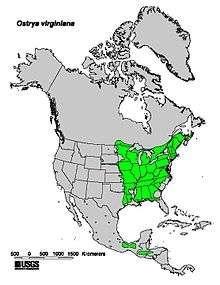Ostrya virginiana
| American hophornbeam | |
|---|---|
 | |
| A hophornbeam branch with the characteristic hops, in early summer | |
| Scientific classification | |
| Kingdom: | Plantae |
| (unranked): | Angiosperms |
| (unranked): | Eudicots |
| (unranked): | Rosids |
| Order: | Fagales |
| Family: | Betulaceae |
| Genus: | Ostrya |
| Species: | O. virginiana |
| Binomial name | |
| Ostrya virginiana (Mill.) K.Koch | |
 | |
| Native range | |
| Synonyms[1] | |
| |
Ostrya virginiana, the American hophornbeam, is a species of Ostrya native to eastern North America, from Nova Scotia west to southern Manitoba and eastern Wyoming, southeast to northern Florida and southwest to eastern Texas.[2] Populations from Mexico and Central America are also regarded as the same species, although some authors prefer to separate them as a distinct species, Ostrya guatemalensis.[1] Other names include eastern hophornbeam, hardhack (in New England), ironwood, and leverwood.[3][4]
Description
American hophornbeam is a small deciduous understory tree growing to 18 m (59 ft) tall and 20–50 centimetres (8–20 in) trunk diameter. The bark is brown to gray-brown, with narrow shaggy plates flaking off, while younger twigs and branches are smoother and gray, with small lenticels.[3][5] Very young twigs are sparsely fuzzy to thickly hairy; the hairs (trichomes) drop off by the next year.[6]
The leaves are ovoid-acute, 5–13 cm (2–5 in) long and 4–6 cm (1 1⁄2–2 1⁄4 in) broad, pinnately veined, with an doubly serrated margin. The upper surface is mostly hairless, while the lower surface is sparsely to moderately fuzzy (rarely densely hairy).[3][5]
The flowers are catkins (spikes) produced in early spring at the same time as the new leaves appear. The staminate (male) catkins are 20–50 mm (3⁄4–2 in) long,[3] and arranged in groups of 1–4.[5] The pistillate (female) catkins are 8–15 mm (5⁄16–19⁄32 in) long, containing 10–30 flowers each.[3]
Pollinated female flowers develop into small nutlets 3–5 mm (1⁄8–3⁄16 in) long fully enclosed in a papery sac-shaped involucre 10–18 mm (3⁄8–11⁄16 in) long and 8–10 mm (5⁄16–3⁄8 in) wide.[3] The involucre changes from greenish-white to dull brown as the fruit matures.[5]
American hophornbeam is similar to its close relative American hornbeam (Carpinus caroliniana), which can be distinguished by its smooth bark and nutlets enclosed in open, three-lobed bracts.[5]
Subdivisions
Populations along the Atlantic coast have slightly smaller leaves, and are sometimes separated as O. virginiana var. lasia Fernald.
- Subspecies[1]
- Ostrya virginiana subsp. guatemalensis (H.J.P.Winkl.) A.E.Murray – central + southern Mexico, Guatemala, Honduras, El Salvador
- Ostrya virginiana subsp. virginiana – eastern half of United States, eastern Canada
Ecology
The buds and catkins are important source of winter food for some birds, notably ruffed grouse (Bonasa umbellus).
Uses
It is grown as an ornamental plant and is sometimes used as a street tree.
Its wood is very resilient and is valued for making tool handles and fence posts.
Being a diffuse porous hardwood and having extremely high density and resistance to compression, it is an excellent material for the construction of wooden longbows.
Gallery
|
References
| Wikimedia Commons has media related to Ostrya virginiana. |
- 1 2 3 Kew World Checklist of Selected Plant Families
- ↑ "Ostrya virginiana". County-level distribution map from the North American Plant Atlas (NAPA). Biota of North America Program (BONAP). 2013.
- 1 2 3 4 5 6 "Ostrya virginiana". Flora of North America (FNA). Missouri Botanical Garden – via eFloras.org.
- ↑ Nelson Sutherland, C.H. (2008). Catálogo de las plantes vasculares de Honduras. Espermatofitas: 1-1576. SERNA/Guaymuras, Tegucigalpa, Honduras
- 1 2 3 4 5 Hilty, John (2016). "Hop Hornbeam (Ostrya virginiana)". Illinois Wildflowers.
- ↑ Chayka, Katy (2016). "Ostrya virginiana (Ironwood)". MinnesotaWildflowers.info.
External links
- US Forest Service: Ostrya virginiana.
- Bioimages: Ostrya virginiana.
- University of Wisconsin – Green Bay. Trees of Wisconsin. Ostrya virginiana.
- Virginia Tech Dendrology. Ostrya virginiana Fact Sheet.
- University of Connecticut. Plants Database. Ostrya virginiana.
- Trees, Shrubs, and Woody Vines of North Carolina. Hophornbeam (Ostrya virginiana).
- Yale University. Cyber Flora. Ostrya virginiana.
